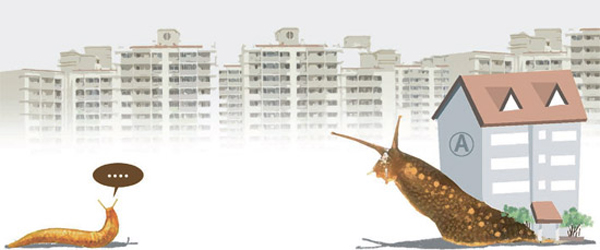The transition from a snail to a slug

In the ’80s, becoming a homeowner became a national goal. In 1980, 44.5 percent of Seoul residents lived in their own homes. The media frequently covered the diminishing prospect of realizing the dream of becoming a homeowner. The situation worsened after the 1988 Seoul Olympics. The shortage of rental homes and soaring housing prices continued until the 1990s, leading many heads of working-class families to kill themselves out of desperation. The police reporters used to focus on two topics - soaring housing prices and rising suicides out of despair.
The cover page of the March 22, 1990 issue of the JoongAng Ilbo featured a story on the tragic reality. The title was “Mom, Are We Moving Again?” A head of a household in his 50s killed himself as the lease deposit for his 3-pyeong (107-square-foot) room increased from 3 million won to 4.5 million won ($2,694 to $4,025). Seventeen people committed suicide over two months for a similar reason. We all feel their desperation and despair. Some even joked that the animal that Koreans are most envious of is the snail, which is born with its own home.
Becoming a homeowner remained at the top of the wish list until 2007. Investment and financial advice books proposed secrets over how to buy a home. They advised to “Start in your 20s, it’s too late in your 30s” and offered the “Top Ten Secret Know-How of Buying a Home.” However, the housing price began to drop after the global financial crisis in 2008, and people are giving second thoughts to becoming a homeowner.
According to a survey by the Ministry of Land, Infrastructure and Transport on last year’s housing situation conducted in May 2013, 27 percent of Koreans feel that they don’t have to buy a home. The number increased by 11 percent compared to two years ago. The average age of buying a first home also went up to 40.9. First, people are getting married at an older age on average, and second, the sluggish economy has put an end to the ever-soaring housing prices. The dream of becoming a homeowner was cherished for over 50 years, but it went down with the aging of society and the economic slump.
Another change in trend is that people are less envious of the snail. The newest joke is, “Young Koreans living today are more like slugs, which have to live without a home for life.”
*The author is an editorial writer of the JoongAng Ilbo.
By Yi Jung-jae
‘내집마련’이 대한민국 고유명사가 된지는 꽤 됐다. 1960년 대 불어 닥친 개발 붐이 시작이었다. 70년 대엔 도시 빈민이 급증했는데, 특히 서울이 심했다. 집 없는 설움을 톡톡히 맛본 서울 서민의 염원 1순위가 ‘내 집 마련’이었다. 당시 상황을 77년 한 신문은 사설에서 이렇게 적고 있다. ‘남의 집 문간방에서 집주인의 눈치를 살피며, 우는 아기의 입을 틀어막아야 하는 어미의 눈에는 한 맺힌 이슬이 핀다. 예나 지금이나 도시서민의 첫째 소원은 제 땅에 제 집 짓고 사는 것이다.’ 80년 대 들어서자 ‘내 집 마련’은 국민적 명제가 됐다. 1980년엔 서울 시민 44.5%만 자기 집에서 살았다. 언론은 ‘멀어져 가는 내 집 마련 꿈’을 단골메뉴로 다뤘다. 88올림픽 이후엔 상황이 극으로 치달았다. 90년까지 이어진 사상 최악의 전세난과 집값 폭등으로 목숨을 끊는 서민 가장이 속출했다. 당시 신문사 경찰출입 기자들은 자고 나면 두 가지를 챙기느라 노심초사해야 했다. ‘오르는 집값’과 ‘전셋값 폭등 비관 자살’이었다. 1990년 3월22일. 중앙일보 1면에 실린 큼직한 기획기사도 그런 비극적 현실을 그린 것이었다. 제목은 ‘엄마 또 이사가? 쫓겨 다니는 내 집 꿈’. 3평에 300만 원 하던 전셋값이 450만 원으로 오르자 비관 자살한 50대 가장 이모씨 죽음이 계기였다. 이렇게 목숨을 끊은 이들이 그 해 두 달 동안 17명. 그 참담함을 짐작할 만하다. 오죽하면 “대한민국 국민이 제일 부러워하는 동물은 ‘달팽이’”란 풍자가 유행했을까. 달팽이는 날 때부터 자기 집을 갖고 태어난다는 이유였다. ‘내 집 마련’은 2007년까지도 국민 염원 1순위 자리를 지켰다. 웬만한 인기 재테크 책엔 ‘내 집 마련 비법’이 빠지지 않았다. ‘20대부터 시작하라, 30이면 늦으리’ ‘남들은 모르는 내 집 마련 노하우 10가지’ 등. 하지만 이듬해인 2008년, 세계 금융위기로 집값이 떨어지자 ‘내 집 마련’의 위상에도 마침내 변화가 생겼다. 2013년 5월. 국토교통부는 지난해 주거실태조사를 해보니 “내 집 마련 안 해도 된다”는 국민이 27%, 2년 전보다 11%포인트나 늘었다고 엊그제 밝혔다. 내 집을 처음 장만하는 평균 나이도 불혹(40.9세)까지 올라갔다. 고령화로 결혼 연령이 늦어진 게 첫째 이유요, 경제가 나빠지면서 집값 상승 신화가 끝났다는 게 두 번째다. 50여 년 요지부동이던 ‘내 집 마련’ 꿈의 쇠락, 고령화와 경기 침체가 낳은 또 다른 풍경이다. 달라진 건 또 있다. 달팽이에 대한 질시도 줄었다. 대신 요즘엔 이런 풍자가 유행 중이란다. “이 시대 대한민국 청년과 가장 닮은 동물은 민달팽이다. 왜냐고? 날 때부터 평생 집 없이 살아야 하니까.” 이정재 논설위원










with the Korea JoongAng Daily
To write comments, please log in to one of the accounts.
Standards Board Policy (0/250자)